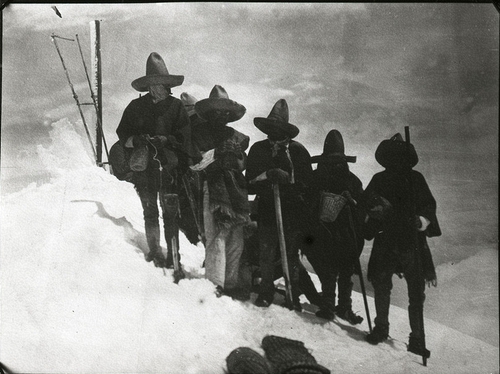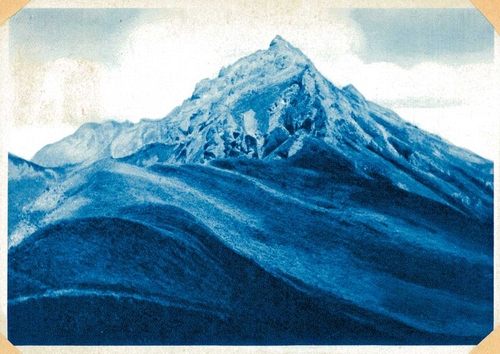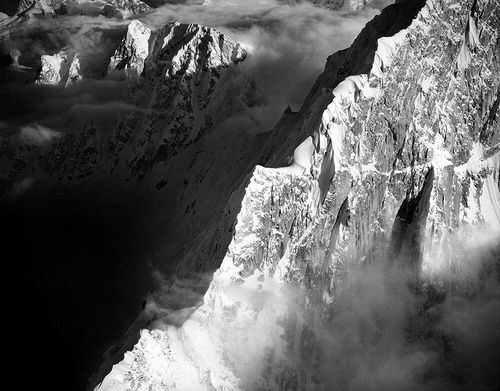Welcome to another Luminous-Lint Newsletter.
A most Happy New Year to you.
To all Luminous-Lint subscribers and contributors I'd like to say thanks for your continuing support.
Mountains, mountaineers and the landscape |
Luminous-Lint has Themes that address each of the following kinds of landscapes:
The definition of landscape has been extended to include cityscapes, gardens and fantasies such as those by Jerry Uelsmann, Maggie Taylor, Fran Forman, Paul Biddle and others. Rural pathways, tracks, trails and lanes
are covered as a distinct theme because although they cross multiple landscape types and pass by others they were frequented by photographers.
Each of these landscape types includes examples, references, introductory sections and details on significant photographers. Like everything on Luminous-Lint topics are fluid and enhanced on a regular basis as additional photographs and additional analysis is carried out.
In this newsletter I'll examine how mountains have been photographed. This topic has been covered in overviews such as that by Elisabeth Foch in La Montagne des photographes, (Paris: Ed. Bordas / Contre-jour, 1989). Twenty-eight albumen prints by Ernest Edwards were tipped-in to the studies of glaciers by George Hereford Brooke in The Oberland and its Glaciers: Explored and Illustrated with Ice-Axe and Camera, (London: Alfred W. Bennett, 1866). Individual mountains have been covered such as the book by George Lowe & Huw Lewis-Jones in their volume The Conquest of Everest: Original Photographs from the Legendary First Ascent, (Thames & Hudson, 2013).
The photography of F. Maxwell Lyte in the Pyrenees has been discussed in a 2004 article by Hélène Saule-Sorbé. From 1863 to 1870 Samuel Bourne wrote numerous articles for The British Journal of Photography describing his photographic travels in the Himalayas. Ansel Adams in Yosemite and the High Sierras took regional studies of specific mountain ranges having one of his famous photographs published on a Hills Brothers coffee can in 1969.

Choiselat & Ratel, Valley in the French Alps [Tal in den Französischen Alpen], 1845, Daguerreotype, 20.6 x 16.3 cm, Private collection of W. & T. Bosshard, Courtesy of Carl Mautz Vintage Photography & Publishing
LL/16202
From the 1840s daguerreotypes were being taken in mountains and valleys. Choiselat & Ratel took some of the finest views ever taken in the French Alps. Joseph-Philibert Girault de Prangey between 1845 and 1850 daguerreotyped mountains in Switzerland and France. Art critic John Ruskin and Frederick Crawley took views Chamonix in 1854 including a remarkable plate of the Mer de Glace shown below, and an unknown photographer took a view of the Andes which is the collection of the Musée du quai Branly in Paris (PM000177, 70.2015.17.1).

John Ruskin and Frederick Crawley, Mer de Glace, Chamonix, 1854, Daguerreotype, The Ruskin Library and Research Centre, Lancaster University, RF Dag75
LL/85685
In addition to views there are illustrations and photographs of mountaineers and those attempting to capture a visual record. Mark Twain in his book A Tramp Abroad (1860) related the difficulties of taking mountain scenery:
But lonely, conspicuous, and superb rose that wonderful upright wedge, the Matterhorn. Its precipitous sides were powdered over with snow, and the upper half hidden in thick clouds which now and then dissolved to cobweb films and gave brief glimpses of the imposing tower as through a veil. A little later the Matterhorn1 took to himself the semblance of a volcano; he was stripped naked to his apex around this circled vast wreaths of white cloud which strung slowly out and streamed away slantwise toward the sun, a twenty-mile stretch of rolling and tumbling vapour, and looking just as if it were pouring out of a crater.
1 I had the very unusual luck to catch one little momentary glimpse of the Matterhorn wholly unencumbered by clouds. I levelled my photographic apparatus at it without the loss of an instant, and should have got an elegant picture if my donkey had not interfered. It was my purpose to draw this photograph all by myself for my book, but was obliged to put the mountain part of it into the hands of the professional artist because I found I could not do landscape well.
Nineteenth century magazine and book illustrations showed intrepid photographers descending cliffs with cameras and tripods slung across their backs or huddled in a storm on Mt. Olympus in Cyprus. A little later one postcard shows a windblown photographer perched precariously on rocks attempting to capture the scenery. In the George Eastman Museum (Record Id: 1975:0111:1011) there is a Chusseau-Flaviens glass negative dated ca 1900-1919 of a photomontage showing Prince Albert of Belgium climbing with his companions.

Unidentified photographer, Henry Mowbray Cadell (?), Five men with Mexican hats on a snow-covered mountain summit, 1902-1910 (?), Glass negative, British Geological Survey, geoscenic.bgs.ac.uk, © NERC, Henry Mowbray Cadell archives, P number: P768887
LL/65394
Scattered through public and private collections there are stunning, and little-known, examples of mountain photography. Luminous-Lint brings these together into increasingly coherent frameworks.

Unidentified photographer, [Untitled - Snow covered mountains, South America], [Album "South America: Venezuela, Colombia, Equador"], n.d., Photograph, National Museum of Denmark, Royal Danish Geographical Society's archive, File Identifier: 200797
LL/92413
The article "Scientific Intelligence: A Photographic Ascent of Mont Blanc" in the The London Review (1861) gave an account of an ascent of Mont Blanc by French photographer Auguste Rosalie Bisson:
M. Auguste Bisson, the well-known Alpine photographer, has recently put into execution a project which has occupied his thoughts for some years past. This is no less than the ascent of Mont Blanc with all the paraphernalia necessary to the obtaining large photographic views from the summit; but, in spite of the well-known energy and talent of this operator, and the experience he has gained during his many photographic excursions at lower elevations, so formidable an enterprise occasioned many of M. Bisson's friends to have serious misgivings as to the success of the attempt. He started from Chamonix with the guide, Auguste Balmat, and twenty-five porters; for in order to carry the large amount of apparatus to such an altitude it was necessary that it should be well distributed. When they reached the Petits Mulets they encountered a terrible storm of wind, accompanied with avalanches falling on every side, which compelled the party to beat a retreat to the Grands Mulets. Arriving there, some of the bearers were too ill to proceed, and had to be sent back, while the party waited until seven hardier porters could be sent up to them from below. Upon these arriving the ascent was recommenced, and at length the summit was reached. There, almost all the party were so overcome by sleep or exhausted by fatigue and suffering as to be unable to move, leaving Balmat and Bisson, whose photographic ardour sustained his strength, the only ones capable of thinking of the reproduction of that magnificent panorama which lay stretched out beneath them. The photographer and his brave companion set up the tent and arranged the materials, but when they attempted to melt the snow in order to supply themselves with water, the fuel which they had brought with them for this purpose refused to light on account of the rarity of the atmosphere. In spite of all these difficulties three pictures were obtained, of which two are said to be very satisfactory. The time occupied on the summit of the mountain did not exceed two hours and a half.
 LEFT: Bisson frères, Savoie 44, L'Ascension du Mont Blanc, 1861, Albumen print, 37,3 x 22,7 cm, Millon et Associés, Auction, Photographs, 7 November 2017, Lot: 34
LEFT: Bisson frères, Savoie 44, L'Ascension du Mont Blanc, 1861, Albumen print, 37,3 x 22,7 cm, Millon et Associés, Auction, Photographs, 7 November 2017, Lot: 34
LL/78289
RIGHT: Auguste Rosalie Bisson, Great Crevasses at the Foot of Mont Blanc, 1871, May (published), Magazine illustration, Google Books - "The Monarch of the Mountains", Harper's New Monthly Magazine, No. CCLII, May, 1871, Vol. XLII, p.815
LL/42582
The examples here are a smattering of the 613 photographs and illustrations used to illustrate the Luminous-Lint Theme on Mountains.
Some of the mountain photographers discussed on the website include: John Stewart, Farnham Maxwell Lyte, Jean-Jacques Heilmann, Vicomte Joseph Vigier, Samuel Bourne, Bisson frères, Charles Soulier, Auguste Rosalie Bisson, William Henry Jackson, Frank Sydney Smythe, Antione Sevruguin, Louis F. Murdock, Albert Steiner and the aerial photographers Eduard Spelterini, Vittorio Sella and Bradford Washburn.

Bradford Washburn, The French ridge, Mt. Huntington's incredible Western ridge seen in wintery twilight, 1964, Gelatin silver print, Decaneas Archive, Courtesy of the Decaneas Archive
LL/31909
Suggestions for additional photographs are always welcome.
So who has been involved in Luminous-Lint to date? |
Given the scale of Luminous-Lint it is difficult to remember all the names of those who have helped in ways both large and small. Having said that one should always try so I‘ve added an "Acknowledgements" page to get the ball rolling. As you go through it you will get a sense of the truly international scope of this project.
My gratitude to you all for subscribing to, and supporting, Luminous-Lint.
Free Trial of Luminous-Lint |
A FREE TRIAL for the website is currently available so send an email to alan@luminous-lint.com with your name and reasons for wanting to take a look and I'll set up a password for you.
  
Educational subscriptions |
It is time to ensure that your subscription to Luminous-Lint has been confirmed. Please check with whoever manages subscriptions to digital resources to ensure all is well. If you are a professor, researcher or student requiring access to Luminous-Lint please contact your Head of Department or Librarian.
If you need any assistance with curriculum planning or resources to supplement your courses send me an email.

The following Themes were updated on 16 January 2020.
Air transportation
Airplanes
Albumen prints
Amateur photography
Archaeology
Architecture
Art
Backgrounds and foregrounds
Backmarks
Brazil
Cameras
Carte de visite
Children
Christian architecture
Cityscapes - Urban
Columns, plinths and pedestals
Composition
Crime and punishment
Curtains
Daguerreotypes
Dark tents and dark boxes
Documentary
Earliest war photographs (1840-1870)
Early examples of photo reportage
Egypt
Ephemera
Experimental and manipulated photography
Exteriors of photographic studios
Finland
Flora
France
Gardens
Germany
Group portraits
Hand-painted photographs
Humour
Ice and snow
India
Islamic architecture
Islam
Jules Verne: Around the World in Eighty Days
Kodak
Land transportation
Life stages
Medical
Native Americans
Night
Norway
Occupational
Occupations and roles
Orientalism
Painting on photographs
Paris
Photograph frames and easels
Photographer and studio labels
Photographers
Photographic studios
Photographing art - paintings and drawings
Photography assimilated into popular culture
Photomontage
Poland
Railways
Religious architecture
Rivers and streams
Rooms and their contents
Rural pathways, tracks, trails and lanes
Salt prints
Scientific
Second World War (1939-1945)
Sequences and series
Snapshots
Social life of photographs
Staircases
Stamps
Stereoviews, stereographs and stereocards
Street: Classic French examples
Sweden
Travel
Trees
Wagon trains
Wagons, carts, carriages and buggies
War
World's Fairs and International Exhibitions
Year of Revolutions (1848)
If you have suggestions for examples and subjects that should be added please let me know.
|
|

